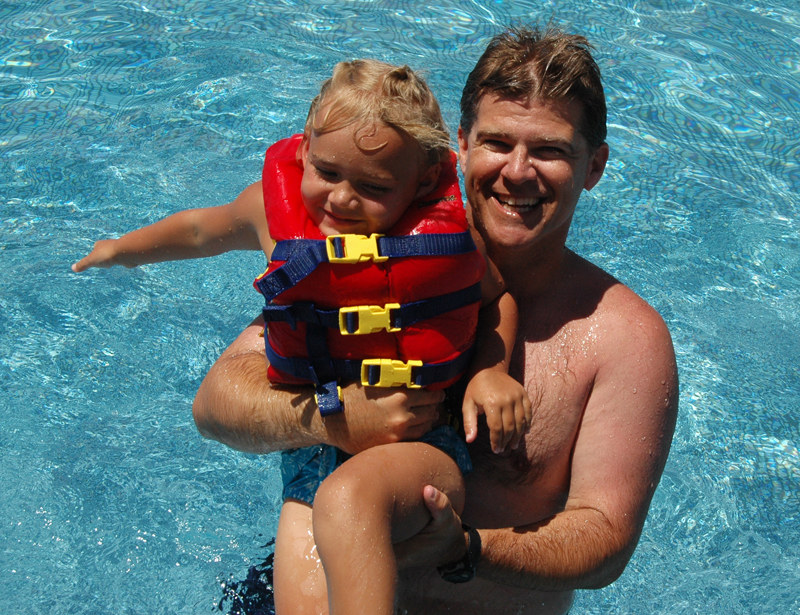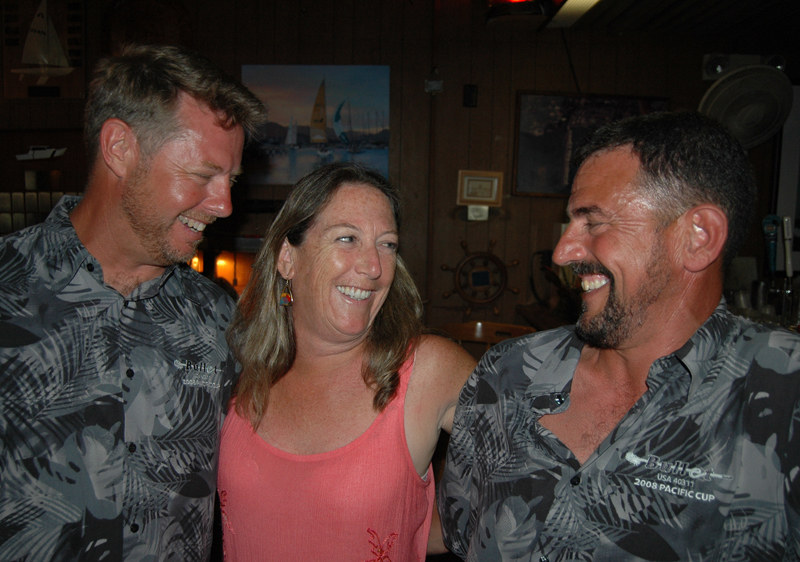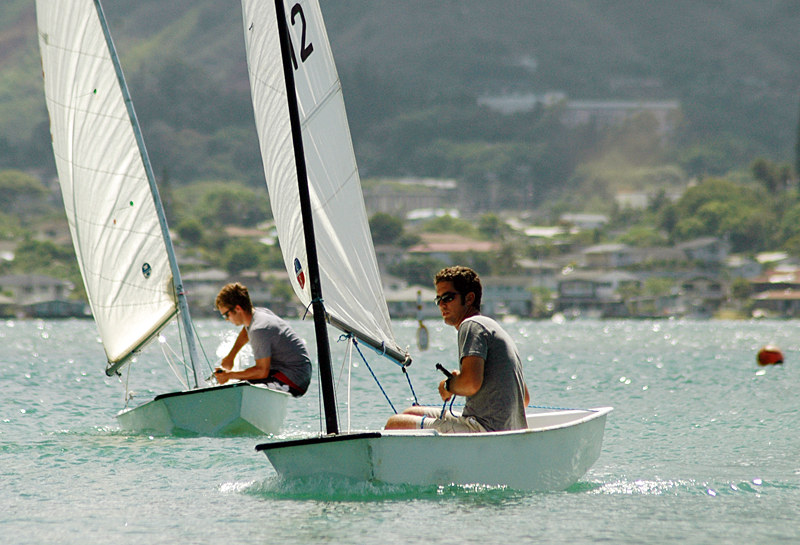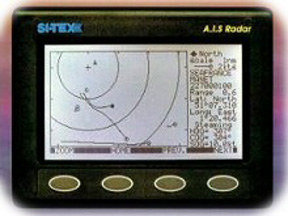
Pacific Cup Trophies Tonight

© Latitude 38 Media, LLC
After nearly a week of poolside lounging, cold-beverages, and parties, the 2008 Pacific Cup wraps up tonight with the trophy presentation at Kaneohe YC. In light of that, here’s a rundown of this year’s winners and some parting shots. We’ll have full coverage in the September issue of Latitude 38.

©2008 Latitude 38 Media, LLC
Overall:
1) Rain Drop, Cascade 36, Joby Easton/Bill Huseby — 1st Doublehanded 1, Latitude 38 Performance Trophy
2) Sleeping Dragon, Hobie 33, Dean Daniels — 1st Division D
3) Sapphire, Synergy 1000, Dave Rasmussen — 2nd Division D, Carl Schumacher Trophy
4) Bullet, Express 37, Michael Maloney 1st Division C
5) E.T., Antrim 27, Todd Hedin — 3rd Division D
6) Criminal Mischief, R/P45, Chip Megeath — 1st Division F
7) Bar-ba-loot, Moore 24, Andy Hamilton/Sarah Deeds — 1st Doublehanded 2
8) Checkered Past, Wyliecat 39, Chris Gibbs — 1st Division B
9) Sabrina, Calkins 50, Chris Calkins/Norm Reynolds — 1st Division E
10) Recidivist, Schumacher 39, Ken Olcott — 2nd Division E
First Elapsed Time:
1) Pegasus OP-50, Owen/Clark 50, Philippe Kahn/Richard Clarke — 7d, 15h, 17m, 50s
Bluewater Sailing Family Trophy: Sapphire
Storm Trysail Club Team Trophy: Encinal YC, Shaman, Cal 40 Steve Waterloo, Azure, Cal 40 Rodney Pimentel, Music, Nordic 44, John McCartney;

© Latitude 38 Media, LLC
The Pacific Cup lives up to its billing as "The Fun Race to Hawaii," in part due to the reception awaiting the crews and families when they arrive at Kaneohe Bay. From the "leis and trays [of mai tais]" and Mooring Committees, to the crew sighting the finish from the Marine Corps base and the folks on the race deck, the volunteer effort at Kaneohe YC was pretty remarkable. All these people worked through the weekend, getting little sleep, if any at all. Then, when Monday or Tuesday rolled around, many had their day jobs to return to.

©2008 Latitude 38 Media, LLC
It wasn’t just the number of members or even non-members who were there through the nights and days, greeting boats as they arrived. It’s that each one seemed genuinely happy to be there doing it, genuinely concerned that the crews got a warm reception and that everyone felt welcome. Over here on the mainland, the notion of the "aloha spirit" often seems like a hollow caricature of itself, like when a marketer tells us to expect an ethereal blast of "aloha" every time we open a can of their macadamia nuts. At Kaneohe YC the "aloha spirit" is alive, and it’s for real.
Clearing the Air on AIS in Mexico

Recently there has been a lot of misinformation about AIS systems, regarding what they cost, what they do, and whether they will be required in Mexico this winter.
First of all, there are two types of AIS systems. First, there are receiver-only units, which have been advertsied in Latitude for under $400. Second, there are receive-and-transmit units. You can buy the Raymarine receive-and-transmit units from West Marine for about $1,000. They don’t cost $4,000 — unless you own a big ship.
A couple of years ago, there was an official in Mexico who wanted AIS transmit-and-receive units on all recreational boats in Mexico because ‘that’s what is required in the United States and Canada’. As all of you know, AIS units are not required on recreational boats in the U.S. and Canada. Anyway, that proposal never came to pass.
Despite the replacement of several officials, the AIS requirement is apparently once again being batted about by some Mexican officials. Before anyone freaks out, we don’t think a law is going to be passed requiring them — at least not anytime soon. One of the big reasons is that such units are not available in Mexico, so how would the thousands of recreational boats in Mexico be required to have something they can’t buy?
In addition, we think the Mexican officials will soon come to their senses about the facts: 1) AIS units are not required in the U.S., and 2) AIS units won’t do what some Mexican officials apparently think they will — such as help in their battle against drug smuggling.
One cruiser who wrote in supporting the requirement said she would do so because it would help prevent drug smuggling. This is ridiculous, as smugglers would simply turn the units off like they would turn off their running lights and VHF radios. When you’re smuggling millions of dollars of drugs, getting busted for not having an AIS on is not a consideration.
Others are suggesting that Mexican officials be placated by requiring that all boats have EPIRBs instead of AIS units. The only way this makes sense is as throwing a bone to Mexican officials, because AIS and EPIRB functions are completely different, and only overlap in the smallest of ways.
Our recommendation is that everyone relax until Tere Grossman, President of the Mexican Marina Owner’s Assocation, advises mariners how and when to respond. For example, it is never productive for gringos to harshly criticize Mexican officials.
Our second reccomendation is that owners of cruising boats seriously consider buying at least the receiver AIS unit. For one thing, they are a great way to keep from getting run down by ships. All you do is set a distance guard, and if a ship enters that zone, an alarm goes off. You have that feature on your radar? Great, but not that great, as radar guards don’t work when it’s raining. Actually, they work too well, going off all the time.
A second reason to have a receiver is that, by all reports, they are amusing as all get out. You get to identify all commercial traffic in your area, where they are going, how to contact them, if they are on course to run you down, and so forth. As you’ll read in the current Latitude, cruisers in the Canal love to get the poop on the ships going through the Canal.
For most cruisers, there aren’t as many good reasons to buy a transmit-also AIS, but there is one. If you or your watch has fallen asleep and a ship is approaching, he’ll know you’re there, even if he can’t see you on radar, and probably give five blasts before running you over.
Bottom line? Everyone should just chill for right now, and in the meantime, look into whether or not buying either type of AIS unit is the right thing for you — even if not required.
If you’ve been using AIS, we’d love to get your review.
